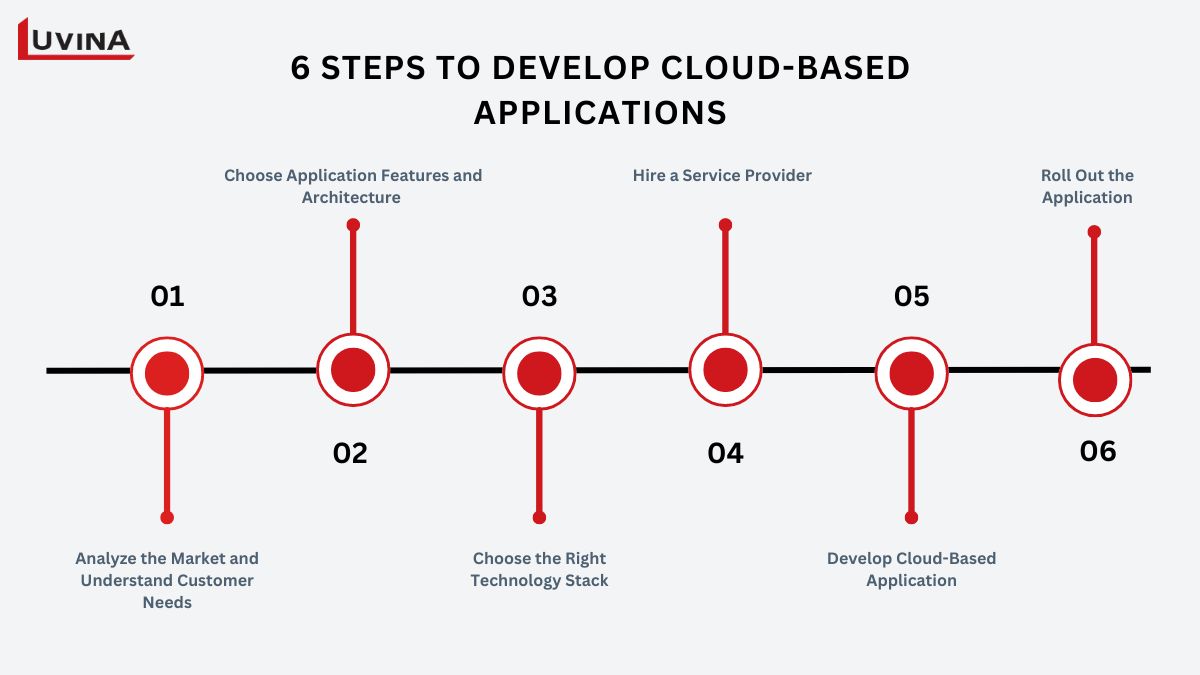According to Statista, over 60% of company data is stored on cloud platforms, and the cloud application market is expected to reach $168.6 billion by 2025. These numbers speak for themselves and clearly show why you should start learning to develop cloud based application today.
If you’re looking to create a unique cloud solution for your business, read our guide below to learn what cloud applications are and explore the essential steps of cloud based development process.
What are cloud-based applications?
Cloud applications are apps that use cloud services. These applications can automatically store data, allowing users to run the app even when offline, and automatically update the data when the app comes back online. Additionally, cloud applications can operate and be accessed from anywhere, as long as the device has a good internet connection.

Cloud based software development means creating an app that leverages cloud services like data storage, databases, and servers.
How to build a Cloud-based app from scratch
To develop cloud based application, here are 6 important steps you can follow:

Step 1: Analyze the Market and Understand Customer Needs
Cloud based development is meant to meet the needs of a specific target audience. Therefore, before you develop cloud based application, you need to explore global market trends and identify the challenges your target audience is facing. This step will help you gain a deeper understanding of the business solution you plan to offer and how it can help users overcome their difficulties.
Additionally, in this step, you should also define your business objectives and the vision for how the application will operate. This includes factors like development costs, timelines, and other planning aspects of cloud based software development. Moreover, researching your competitors can also help you optimize your cloud application to better attract your target customers.
Step 2: Choose Application Features and Architecture Based on Business Requirements
After researching the market, the next step is to select the features you want to integrate into your application and choose an application architecture that meets your needs. Deciding on features, service models, cloud migration approaches, and application architecture early on will help you develop cloud based application more optimized.
When choosing application features, consider factors such as multi-platform accessibility for users, security-related features, real-time collaboration tools like live chat, comments, co-editing, and user notifications. Next, you need to select and arrange the components in the cloud-based application architecture. The choice of architecture will largely depend on your specific application requirements. For example:
- Monolithic Architecture: This creates an application as a tightly integrated unit where all components are connected and interdependent.
- Microservices Architecture: This divides the application into small, independent services, each with its own functionality, communicating through APIs.
- Serverless Architecture: The application is built using small functions that run in a serverless environment, triggered by events.
- Hybrid Cloud Architecture: This combines on-premise infrastructure with public or private cloud resources.
>> Also read: Top 9 Cloud-Based Development Platforms
Step 3: Choose the Right Technology Stack to Develop Cloud Based Application
Whether you’re working on cloud based software development, cloud based web application development, or cloud based mobile application development, the selection of proper technology stack is very vital to developing a highly functional application.
It is necessary to choose the technology stack depending on the feature set of the application, design, and the requirements of the project scope, volume, and type of integrations, and the required security level. For example, Python might be included in the list of development technologies for creating scalable and easy-to-support cloud solutions. At the same time, Ruby on Rails development might become an optimal solution for projects that require fast idea visualization and preliminary testing.
Exploring different applications, data, utilities, and business tools can further assist you in cloud based mobile app development for your business.
| Application & Data | Utilities | DevOps | Business Tools |
| Akamai Cloudant | – Google Analytics – Heap – Zuora | – Jenkins – Datadog – StillAlive | – Jira – G Suite – DocuSign – Salesforce Sales Cloud |
However, remember that there is no one-size-fits-all solution for every business.
>> Also read: How to Choose the Right Cloud Service Development Tools
Step 4: Hire a Service Provider for Cloud Based Development
To successfully build cloud solutions or develop cloud-based applications effectively, you need an experienced development team capable of using various methods to create the application. Cloud application development teams must meet several requirements, such as being familiar with cloud service providers, having a forward-thinking and flexible mindset to plan the application architecture well, and focusing more on the product rather than just coding. Look for true product development experts rather than just a group of programmers.
You can outsource freelance developers, create an in-house IT team, or outsource to professional cloud-based software development companies. If you are hiring any technology company, see how many cloud solutions they have been building, what services will they offer, and their expertise, and read reviews from their previous clients.
Step 5: Develop Cloud-Based Application
Once you have hired a team of specialists or chosen the most suitable cloud-based software development provider, the experts will start building your application according to your requirements. The first step will be to create frameworks and prototypes to help you understand how the features will work and estimate the time needed to develop the application. Next, the UX/UI team will design a user-friendly interface to determine how users will interact with the system and make the most of the cloud services.
The cloud-based development process typically employs methodologies like Scrum or Agile, as this development process can be quite complex and time-consuming.
After the development of the application is complete, tests such as unit testing, integration testing, and user acceptance testing will be performed by the quality assurance team to ensure that the application runs seamlessly on all platforms and devices. Any problems found in this stage will be resolved at the earliest. Above all, the performance and scalability of the application will also be under testing by the quality assurance team to ensure it bears the expected load without any hassle.
Step 6: Roll Out the Application
The final stage of cloud based mobile application is deploying the application on app stores like Google Play or the Apple Store. This launch process can take anywhere from 48 hours to 7 days. To optimize the application and speed up the deployment, ensure that it complies with the app store guidelines and that all required information about the app is provided.
However, the deployment step is not the end. Your application needs continuous maintenance after deployment. Regularly update security patches to protect data, optimize application performance, adjust scalability if user traffic increases, and update technology stacks when new versions are released. You can also add new features and fix any bugs as needed.
>> Also read: A Practical Guide to Cloud Deployment Models
Examples of Best Cloud-based Applications
Today, there are many cloud-based applications in widespread use that you might not be aware of. Here are some examples:
| Cloud based application | Description | Features |
| Dropbox | An easy cloud storage to store files in the cloud and access them from any location. | – Store and access files from anywhere – Bring content altogether – Give access to the right people |
| Miro | A virtual board where you can collaborate with others in a more engaging and creative way. | – Collaboration in real-time. – Text and video chat – Screen-sharing and presentations |
| Figma | A cloud-based design application that helps designers create designs more efficiently. | – Create designs for the web – Automate work with plugins and widgets – Auto layout components stretch for easier responsive design |
| Netflix | One of the most popular streaming services, relying on cloud computing to deliver a vast library of content to millions of subscribers. | – Streaming movies and TV shows – Video streaming |
| Spotify | Using cloud servers to offer access to a massive library of songs and podcasts, allowing users to stream or download content based on their preferences. | – Music streaming |
| Google Drive | A cloud storage service allows users to store files online and access them from any device. | – Document sharing and collaboration |
| Zoom | A video conferencing service that operates entirely in the cloud, offering scalable solutions of video conferencing and virtual meetings for both personal and business use. | – Chat rooms – Direct messaging – File sharing |
How can Luvina help?
We hope the detailed guide above has helped you better understand how cloud based development can elevate your business and provide long-term benefits. At Luvina, we offer cloud based software development services tailored to various industries. By leveraging cloud solutions, Luvina enables businesses to focus on core operations while ensuring robust and secure cloud IT infrastructure. Currently, we offer cloud development service that can help developers accelerate speed, enhance flexibility, and improve scalability and reliability, all while being cost-effective.

Once you contact Luvina, our consulting team will reach out to provide detailed answers to any questions you may have about cloud-based application development. Choose to collaborate with Luvina to:
- – Experience excellent service quality provided by a leading company certified with ISO 9001.
- – Work with a team of over 750 skilled professionals who ensure stable software and application performance.
- – Ensure enhanced security: Luvina adheres to international security standards such as ISO 27001 throughout the collaboration to keep your data and intellectual property safe.
- – Flexible scalability: Our IT specialists can adjust the scope according to the needs and scale of the project without any obstacles.
Related Posts:
- Essentials Cloud Outsourcing Guideline
- A Path to Success Cloud Transformation Strategy
- Top 15 Best Cloud Development Company
Contact Luvina today to develop cloud based application with our experienced developers.









Read More From Us?
Sign up for our newsletter
Read More From Us?
Sign up for our newsletter